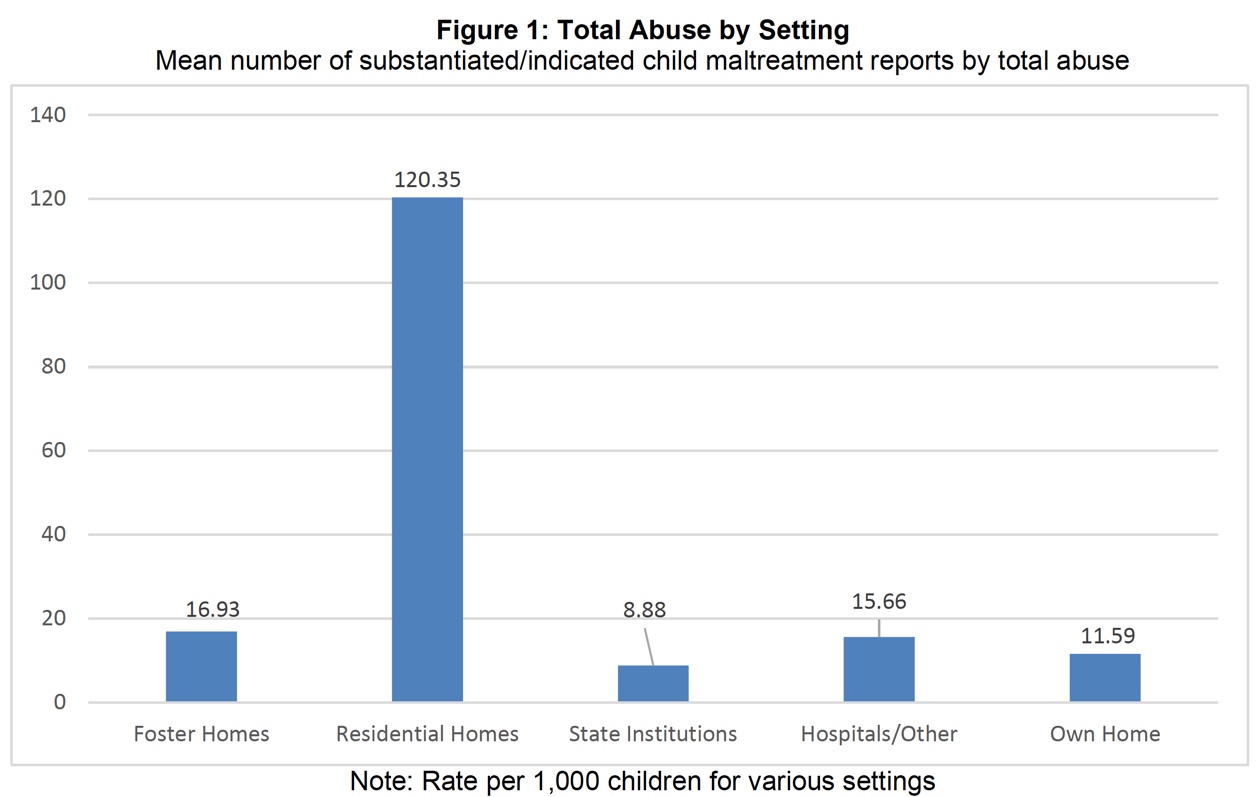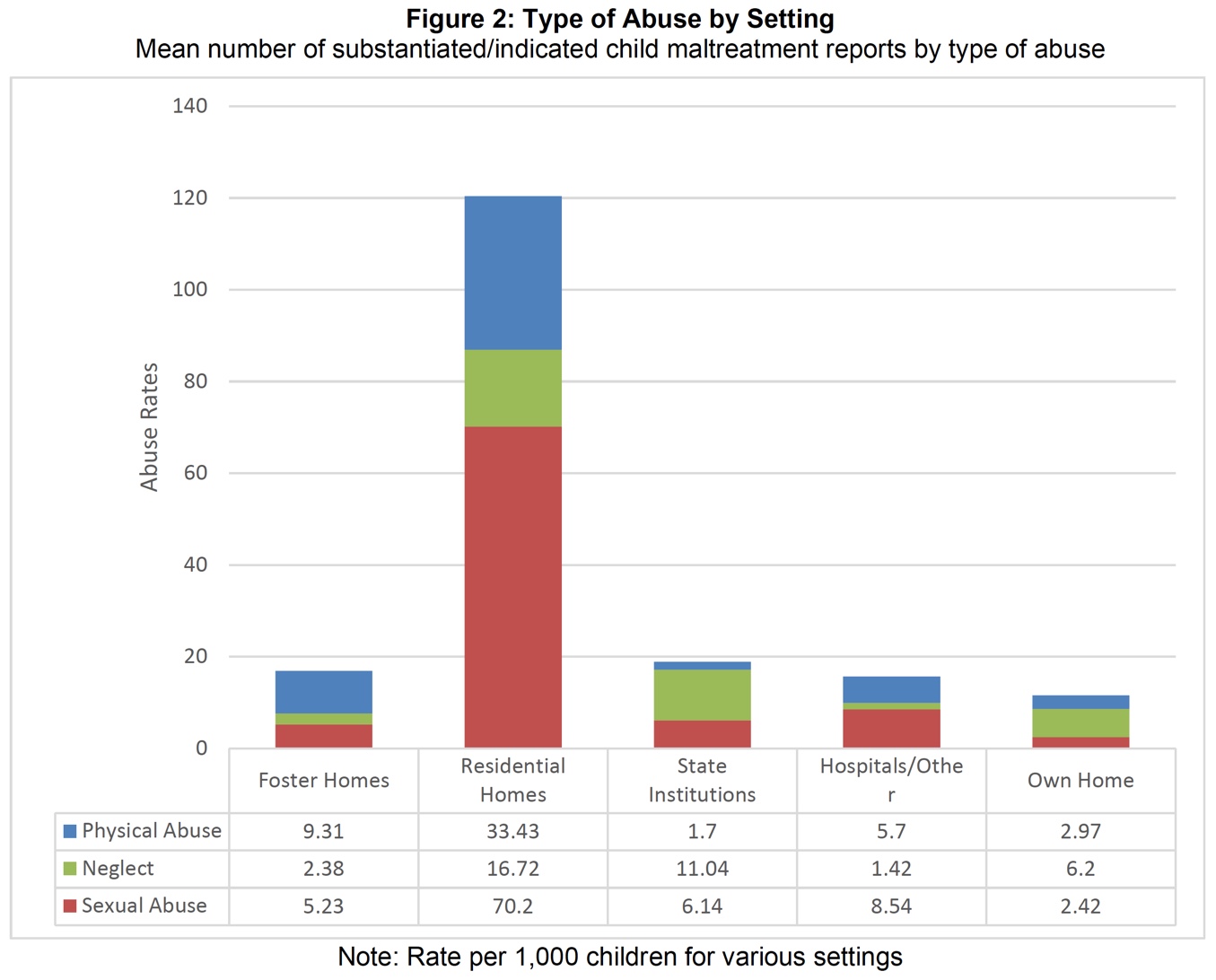SETTINGS OF ABUSE
Institutional Settings
Rates of elder abuse and neglect are higher in institutional settings as compared to community settings (Yon et. al., 2019). Institutional settings where elder abuse occurs include hospitals, nursing homes and long-term care facilities (Yon et. al., 2019). Although elder abuse is prevalent in institutional settings, research on this issue is still in the early stage of development (Pillemer et. al., 2016). In a meta-analysis based on staff reports from four studies, approximately two in three staff admitted to committing elder abuse within the past year (Yon et. al., 2019). When broken down by types of abuse as reported by staff, the rate of psychological abuse was 32.5 percent, followed by neglect (12 percent), physical abuse (9.3 percent), and sexual abuse (0.7 percent) (Yon et. al., 2019).
While there was not enough evidence to report the overall prevalence of abuse based on self-reported data from elderly patients, an analysis of abuse subtypes showed that psychological abuse was the most common at 33.4 percent (Yon et. al., 2019). Physical abuse followed at 14.1 percent, then financial abuse (13.8 percent), neglect (11.6 percent), and sexual abuse (1.9 percent) (Yon et. al., 2019). There are limited studies on the prevalence of elder abuse in institutional settings, and the current studies project a wide range of prevalence rates (Yon et. al., 2019). The rates from Yon and colleagues (2019) do not capture the overall rates of elder abuse and neglect in institutions and do not show the full extent of the issue of elder abuse in institutional settings. Given this limited amount of research, future studies should clearly define the population of study, the sources of abuse (staff-to-resident abuse, resident-to-resident abuse, or visitor-to-resident abuse), characteristics of the institution (staff-to-patient ratios, care guidance, ratio of trained staff, etc.), use of measurement tools, and data collection methods (questionnaires vs. face-to-face interviews) (Yon et. al., 2019). Overall, additional research on elderly abuse in institutional studies will aid researchers and policymakers in creating an environment where the rights of elderly adults to live without prejudice, abuse and violence will be protected (Yon et. al., 2019).
When looking at abuse in institutional settings, it is important to keep in mind groups outside of the elderly and those with learning disabilities. Abuse can take place among patients in a normal hospital setting, as highlighted by Kendrick & Taylor (2000). However, there are other settings to consider, aside from hospitals and elderly homes, when discussing patient maltreatment. In a study by Spencer and Knudsen (1992), researchers compared in-home abuse rates from 1984-1990 in Indiana to maltreatment rates in foster homes, residential homes, and state institutions and hospitals. In hospitals and other facilities, residential homes and foster homes, the rates of maltreatment were higher than for children who lived at home (Spencer & Knudsen, 1992). Sexual abuse was the most common form of abuse in hospitals and residential homes, followed by physical abuse and neglect (Spencer & Knudsen, 1992). However, in state institutions, neglect was more common, followed by sexual abuse and physical abuse (Spencer & Knudsen, 1992). Contrarily, in foster homes, physical abuse was more common, followed by sexual abuse and neglect (Spencer & Knudsen, 1992). To protect children in institutional settings from abuse, Kendrick and Taylor (2000) identified three safeguards: listening to children, providing staff with the proper training and support, and using external systems of monitoring, inspection and standards.


Community Settings
While elder abuse is more prevalent in institutional settings, it also takes place in community settings. In a meta-analysis conducted in 2017 of 52 studies from 2002 to 2015, researchers found that, in community settings across the world, an estimated one in six older adults experienced a form of abuse within the past year (Yon et. al., 2017). The type of abuse reported by elderly residents was financial (13.8 percent), psychological (11.6 percent), neglect (4.2 percent) physical (2.6 percent), and sexual (0.9 percent) (Yon et. al., 2017).
In community settings, elderly patients may not have access to the help they need because of the position of the abusers. There also may be patients in other vulnerable groups in community settings or private homes who are abused by their caretaker or someone who is in contact with them, and they may not be able to report their abuse to get the help they need. Caretakers who are also abusers can use neglect or physical, financial, verbal or sexual abuse to control the patient. In community and private home settings, patients may not have access to a healthcare provider, may not be able to Foster Homes ResidentialHomes StateInstitutions Hospitals/Other Own Home Physical Abuse 9.31 33.43 1.7 5.7 2.97 Neglect 2.38 16.72 11.04 1.42 6.2 Sexual Abuse 5.23 70.2 6.14 8.54 2.42 0 20 40 60 80 100 120 140 Abuse Rates voice their concerns, may be fearful of their caretaker or abuser, and/or may not have access to the resources needed to get assistance with escaping an abusive relationship.
